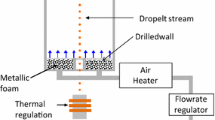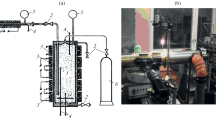Abstract
Concentration measurements of evaporated hydrocarbon species by infrared laser absorption spectroscopy at a monodisperse droplet chain are presented. A droplet generator was installed within a flow channel and operated with cyclohexane, iso-octane, n-heptane, n-pentane and 1-butanol. The flow channel was flushed with a laminar flow of air at different temperatures. The absorption of a HeNe laser beam at \(\lambda = 3.39\,\upmu \hbox {m}\) traversing through the flow channel at varying distances from the droplet chain was exploited to determine the vapor concentrations of the hydrocarbons. Measurements of the absorption cross sections in a heated gas cell (\(T = 300\)–773 K) enabled the quantification of the absorption signals from the droplet chain. Vapor concentrations were determined in planes perpendicular to the droplet chain. From the increase of vapor concentration between the planes, the evaporation rate could be determined. The evaporation rates were measured in dependence of co-flow temperature, droplet velocity, droplet generation frequency and droplet spacing. In the investigated temperature range of the air (313–430 K) the evaporation rates increased linearly with temperature. The order of the fuels with respect to evaporation rates corresponded with the boiling points of the individual fuels. In addition to the presentation of the results, the paper discusses the performance of vapor concentration measurements by laser absorption spectroscopy at droplet chains which has not been tested before in such a configuration. Particular attention was paid to the spatial resolution of the measurement. The results are well suited to validate models and numerical simulations.










Similar content being viewed by others
References
W. Sirignano, Fluid Dynamics and Transport of Droplets and Sprays (Cambridge University Press, Cambridge, 2010)
S.S. Sazhin, Modelling of fuel droplet heating and evaporation: recent results and unsolved problems. Fuel 196, 69–101 (2017)
A.P. Pinheiro, J.M. Vedovoto, Evaluation of droplet evaporation models and the incorporation of natural convection effects. Flow Turbul. Combust. 102, 537–558 (2019)
M. Birouk, I. Gökalp, Current status of droplet evaporation in turbulent flows. Prog. Energy Combust. Sci. 32, 408–423 (2006)
A. Lefebvre, V. McDonnel, Atomization and Sprays, 2nd edn. (CRC Press, Boca Raton, 2017)
S.B. Saharin, B. Lefort, C. Morin, C. Chauveau, L.L. Moyne, R. Kafafy, Vaporization characteristics of ethanol and 1-propanol droplets at high temperatures. At. Sprays 22, 207–226 (2012)
P. Strizhak, R. Volkov, G. Castanet, F. Lemoine, O. Rybdylova, S. Sazhin, Heating and evaporation of suspended water droplets: Experimental studies and modelling. Int. J. Heat Mass Transf. 127, 92–106 (2018)
G. Xiao, K.H. Luo, X. Ma, S. Shuai, A molecular dynamics study of fuel droplet evaporation in sub- and supercritical conditions. Proc. Combust. Inst. 37, 3219–3227 (2019)
S. Horender, M. Sommerfeld, Evaporation of nearly monosized droplets of hexane, heptane, decane and their mixtures in hot air and an air/steam mixture. Int. J. Spray Combust. Dyn. 4, 123–153 (2012)
P. Kulkarni, P.A. Baron, K. Willeke, Aerosol Measurement: Principles, Techniques, and Applications (Wiley, New York, 2011)
F. Lemoine, G. Castanet, Temperature and chemical composition of droplets by optical measurement techniques: a state-of-the-art review. Exp. Fluids 54, 1572 (2013)
C. Tropea, Optical particle characterization in flows. Annu. Rev. Fluid Mech. 43, 399–426 (2011)
Y. Wu, C. Crua, H. Li, S. Saengkaew, L. Mädler, X. Wu, G. Gréhan, Simultaneous measurement of monocomponent droplet temperature/refractive index, size and evaporation rate with phase rainbow refractometry. J. Quant. Spectrosc. Radiat. Transf. 214, 146–157 (2018)
J. Wilms, B. Weigand, Composition measurements of binary mixture droplets by rainbow refractometry. Appl. Opt. 46, 2109–2118 (2007)
C.D. Rosebrock, S. Shirinzadeh, M. Soeken, N. Riefler, T. Wriedt, R. Drechsler, L. Mädler, Time-resolved detection of diffusion limited temperature gradients inside single isolated burning droplets using rainbow refractometry. Combust. Flame 168, 255–269 (2016)
G.S. Settles, M.J. Hargather, A review of recent developments in schlieren and shadowgraph techniques. Meas. Sci. Technol. 28, 042001 (2017)
H.-E. Albrecht, N. Damaschke, M. Borys, C. Tropea, Laser Doppler and Phase Doppler Measurement Techniques (Springer, Berlin, 2003)
Y. Zhao, H.H. Qiu, Measurements of multicomponent microdroplet evaporation by using rainbow refractometer and PDA. Exp. Fluids 40, 60 (2005)
T.D. Fansler, S.E. Parrish, Spray measurement technology: a review. Meas. Sci. Technol. 26, 012002 (2014)
T. Hillenbrand, D. Brüggemann, Substance related investigation of the evaporation characteristics of free falling alkane-ethanol droplets using Raman spectroscopy, in ILASS Europe. 29th European Conference on Liquid Atomization and Spray Systems (2019)
M.A. Linne, Spectroscopic Measurement: An Introduction to the Fundamentals (Academic, Amsterdam, 2002)
D.A. Long, The Raman Effect: A Unified Treatment of the Theory of Raman Scattering by Molecules (Wiley, New York, 2002)
C. Schulz, V. Sick, Tracer-LIF diagnostics: quantitative measurement of fuel concentration, temperature and fuel/air ratio in practical combustion systems. Prog. Energy Combust. Sci. 31, 75–121 (2005)
S. Bejaoui, X. Mercier, P. Desgroux, E. Therssen, Laser induced fluorescence spectroscopy of aromatic species produced in atmospheric sooting flames using UV and visible excitation wavelengths. Combust. Flame 161, 2479–2491 (2014)
M. Orain, P. Baranger, C. Ledier, J. Apeloig, F. Grisch, Fluorescence spectroscopy of kerosene vapour at high temperatures and pressures: potential for gas turbines measurements. Appl. Phys. B 116, 729–745 (2014)
M.C. Thurber, F. Grisch, B.J. Kirby, M. Votsmeier, R.K. Hanson, Measurements and modeling of acetone laser-induced fluorescence with implications for temperature-imaging diagnostics. Appl. Opt. 37, 4963–4978 (1998)
O. Dégardin, B. Renou, A.M. Boukhalfa, Simultaneous measurement of temperature and fuel mole fraction using acetone planar induced fluorescence and rayleigh scattering in stratified flames. Exp. Fluids 40, 452–463 (2006)
S. Sahu, Y. Hardalupas, A.M.K.P. Taylor, Simultaneous droplet and vapour-phase measurements in an evaporative spray by combined ILIDS and PLIF techniques. Exp. Fluids 55, 1673 (2014)
M. Stöhr, S. Werner, W. Meier, Experimental study of liquid-vapor mass transfer in non-reacting and reacting droplet chains, in ILASS Europe. 28th European Conference on Liquid Atomization and Spray Systems (Editorial Universitat Politècnica de València, 2017), pp. 738–745
C. Liu, L. Xu, Laser absorption spectroscopy for combustion diagnosis in reactive flows: a review. Appl. Spectrosc. Rev. 54, 1–44 (2019)
W. Cai, C.F. Kaminski, Tomographic absorption spectroscopy for the study of gas dynamics and reactive flows. Prog. Energy Combust. Sci. 59, 1–31 (2017)
R.K. Hanson, Applications of quantitative laser sensors to kinetics, propulsion and practical energy systems. Proc. Combust. Inst. 33, 1–40 (2011)
F.K. Tittel, R. Lewicki, R. Lascola, S. McWhorter, Emerging Infrared Laser Absorption Spectroscopic Techniques for Gas Analysis, Chapter 4 (Wiley, New York, 2013), pp. 71–109
W. Mallard, W. Gardiner, Absorption of the 3.39 \(\mu\)m He–Ne laser line by methane from 300 to 2400 K. J. Quant. Spectrosc. Radiat. Transf 20, 135–149 (1978)
D.B. Olson, W.G. Mallard, J.W.C. Gardiner, High temperature absorption of the 3.39 \(\mu\)m He–Ne laser line by small hydrocarbons. Appl. Spectrosc 32, 489–493 (1978)
M. Perrin, J. Hartmann, High temperature absorption of the 3.39 \(\mu\)m He–Ne laser line by methane. J. Quant. Spectrosc. Radiat. Transf. 42, 459–464 (1989)
J.A. Drallmeier, Hydrocarbon absorption coefficients at the 3.39 \(\mu\)m He–Ne laser transition. Appl. Opt. 42, 979–982 (2003)
S.J. Ruoff, B. Rauch, P. Le Clercq, M. Aigner, Assessment of the comparability of droplet evaporation fuel sensitivities between a unit test case and an aviation gas turbine combustor, in AIAA Scitech 2019 Forum, 0727 (2019)
C.L. Yaws, Chapter 10—diffusion coefficient in air-organic compounds, in Transport Properties of Chemicals and Hydrocarbons, ed. by C.L. Yaws (William Andrew Publishing, Boston, 2009), pp. 407–496
National Institute of Standards and Technology, NIST Chemistry WebBook. http://webbook.nist.gov/
W. Demtröder, Laser Spectroscopy 1 (Springer, Berlin, 2014)
C.S. Goldenstein, R. Spearrin, J.B. Jeffries, R.K. Hanson, Infrared laser-absorption sensing for combustion gases. Prog. Energy Combust. Sci. 60, 132–176 (2017)
C.J. Dasch, One-dimensional tomography: a comparison of abel, onion-peeling, and filtered backprojection methods. Appl. Opt. 31, 1146–1152 (1992)
E. Tomita, N. Kawahara, M. Shigenaga, A. Nishiyama, R.W. Dibble, In situ measurement of hydrocarbon fuel concentration near a spark plug in an engine cylinder using the 3.392 \(\mu\)m infrared laser absorption method: discussion of applicability with a homogeneous methane–air mixture. Meas. Sci. Technol 14, 1350–1356 (2003)
M.A. Alrefae, Mid-IR Absorption cross-section measurements oh hydrocarbons. Master’s thesis, King Abdullah University of Science and Technology (2013)
R. Mevel, P. Boettcher, J. Shepherd, Absorption cross section at 3.39 \(\mu\)m of alkanes, aromatics and substituted hydrocarbons. Chem. Phys. Lett. 531, 22–27 (2012)
A.E. Klingbeil, J.B. Jeffries, R.K. Hanson, Temperature- and pressure-dependent absorption cross sections of gaseous hydrocarbons at 3.39 \(\mu\)m. Meas. Sci. Technol. 17, 1950–1957 (2006)
Dortmund Data Bank, DDBST GmbH (Version 2015). http://www.ddbst.com/
G. Castanet, L. Perrin, O. Caballina, F. Lemoine, Evaporation of closely-spaced interacting droplets arranged in a single row. Int. J. Heat Mass Transf. 93, 788–802 (2016)
Acknowledgements
The work described in present paper was funded by the German Aerospace Center (DLR) in the frame of internal projects “R2F” and “Future Fuels”. The authors would like to thank Patrick Nau for his valuable support in data analysis and in the lab. The authors also thank Uwe Riedel for useful discussions.
Author information
Authors and Affiliations
Corresponding author
Additional information
Publisher's Note
Springer Nature remains neutral with regard to jurisdictional claims in published maps and institutional affiliations.
Rights and permissions
About this article
Cite this article
Werner, S., Meier, W. Measurement of evaporation of hydrocarbon droplets by laser absorption spectroscopy. Appl. Phys. B 126, 13 (2020). https://doi.org/10.1007/s00340-019-7363-0
Received:
Accepted:
Published:
DOI: https://doi.org/10.1007/s00340-019-7363-0




